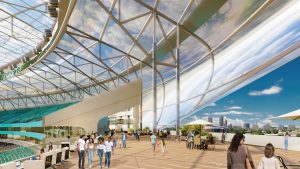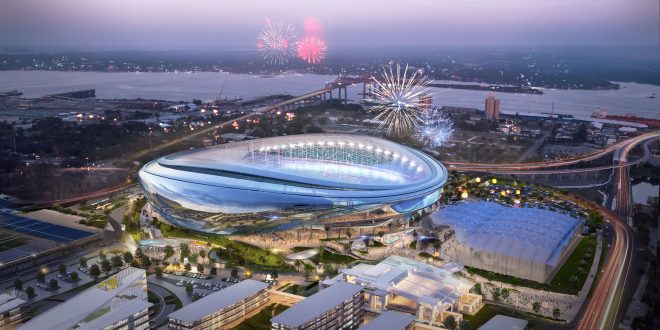The Jacksonville Jaguars just introduced their newly designed stadium for the future. A design project that took nearly three years for the sole purpose of inspiring a transformation of Downtown Jacksonville and securing NFL football in North Florida well into the future.
Jacksonville Planning
Jacksonville city officials and the Jaguars began planning a long-term stadium solution in July 2020. Getting an in-depth engineering assessment of the current stadium, TIAA Bank Field. After the assessment was completed, it concluded that it was possible to solve stadium challenges via a renovation of the city-owned facility versus new construction. There was a comprehensive selection process for a design partner. Fans and other key stakeholders were given in-depth surveys to choose the design partner.
The best is yet to come in Jacksonville. Take an exclusive first look at our vision for the Stadium of the Future.#DUUUVAL
— Jacksonville Jaguars (@Jaguars) June 7, 2023
After selecting its architect for the project team, the Jaguars then collaborated with HOK’s Sports + Recreation + Entertainment practice to help more with definitive renovation plans. “This transformation transcends the stadium’s boundaries,” said Peter Broeder, HOK’s design principal. “The design creates an iconic, accessible community nexus that ties together the surrounding neighborhoods and riverfront.”
Design Highlights
Inspiration from Jacksonville’s lush landscapes will include a web of biking and walking trails, parklands, greenways, beaches and marshes. The entrance will be a subtropical Floridian park, leading fans to the main concourse. The concourse is 30 feet above the ground giving overlook views of Downtown Jacksonville and the St. Johns River. The 360-degree concourse is going to be four times wider than before. It will feature interactive social bars and a variety of unique experiences alongside culinary delights native to Jacksonville.
There will be a base capacity of 62,00o seats with expansion capabilities up to 71,500 for a college football game and more for a concert. Also, lighting and digital technology can transform its appearance that will create distinctive game-day experiences and ensure that fans stay connected.
Additionally, the stadium is designed with sustainability in mind. It will be an open-air venue that features a large canopy so that will reduce heat retention by more than 70%. That will lowers temperatures by 10 to 15 degrees, and protect fans from the weather.

 ESPN 98.1 FM / 850 AM WRUF ESPN 98.1 FM / 850 AM WRUF
ESPN 98.1 FM / 850 AM WRUF ESPN 98.1 FM / 850 AM WRUF




